Bar Exam (Updated and Revised)
I made some major errors in this post initially. Please read this revision
In 2002, M. Russell Ballard, with the endorsement of President Hinckley, issued a challenge to the church that we strive to send those who are truly able and worthy on missions. A few years after, Blake Ostler posted over at Times & Seasons lamenting the loss of those who were seemingly now being denied the opportunity to go, as well as the loss of converts due to this. (see follow up posts on this, and see appendix for follow up on those posts) Today I am revisiting those numbers.
First of all, it is undeniable the number of missionaries has declined greatly since the call to raise the bar.
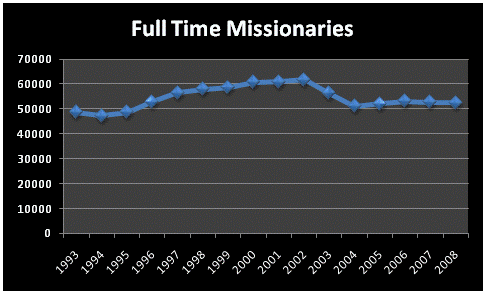
However, one thing we need to look at when examining this loss of force is what other factors are going on here. For example, let’s look at the number of 19 year olds available from being born into the church for this period (making up 90% of the missionary force after allowing for the 2 year differential for sisters; otherwise it is still 75% of the work force) We can get this from the annual statistical reports from the late 70s- 90s.
As we can see, there is a major decline in available youth which corresponds to the loss of missionary force. Since not all 19 year olds members had member parents at birth (and thus were not children of record since children of record is children added that are not yet baptized, usually via blessing and naming), another source for checking this group is seminary enrollments, which is available through the Seminary and Institute Annual report.
As Seminary is inclusive of 4 years of births, and missions are inclusive of 2 years of births, it is particularly interesting that the 2002 drop in missionaries corresponds so perfectly with the 2000 drop in seminary enrollments. Put another way:
While it is true that there is a drop in the percent of 19 year olds members serving missions in 2002, this drop is not the only contributing factor to the decline in missionaries. Compared to the extreme decline in births around 1983, this is less significant. (Note, see appendix 3 for an explanation of the test I did for correlation) This does not mean it is not important, in fact it may mean it is even more important, as the combination of less available staff with less staff volunteering is a true double loss.
Finally, Before or after the bar was raised, about 3 out of 10 LDS youth record as Children of Record served missions.If this correlation holds true, things are going to get worse before they get better, with only 45,000 missionaries by 2017. We won’t see 60,000 missionaries again until 2027.
This means that if congregations continue to grow at about 1% a year, then the church will only have about 1.4 missionaries per ward in 2017 as opposed to its current 1.9 missionaries per ward. Right now, with two missionaries in a ward or branch, about 2000 wards don’t have dedicated full time missionaries, in 2017, that number will quadruple to 8,000 wards or branches (25%) with no missionaries. Things should improve again by 2027, with only 1,300 wards or branches lacking missionaries by then.
Questions:
What happened to mormon fertility in 1983? Did it radically go down, or did people just stop putting their kids on the records suddenly that year?
How do we get more than 3 out of 10 nineteen year olds to serve missions?
Appendix A:
For completeness, since many have wondered about raising the bar bringing more converts per missionary, here are some pertinent charts to consider.
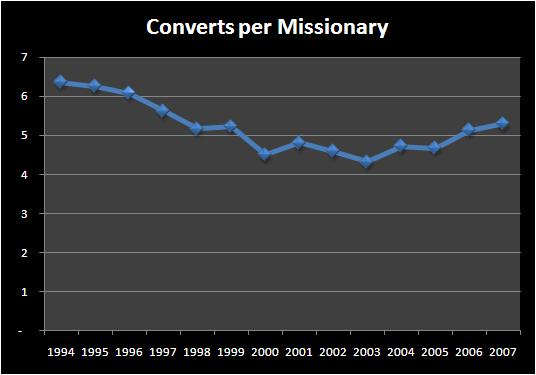
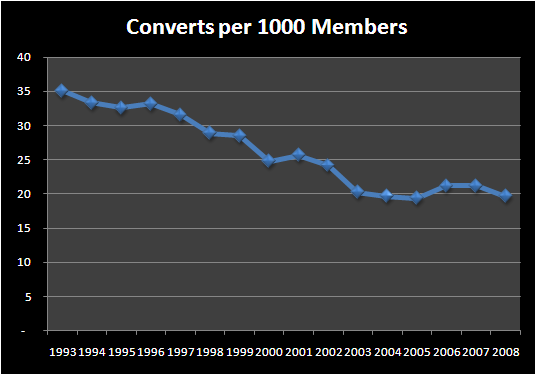
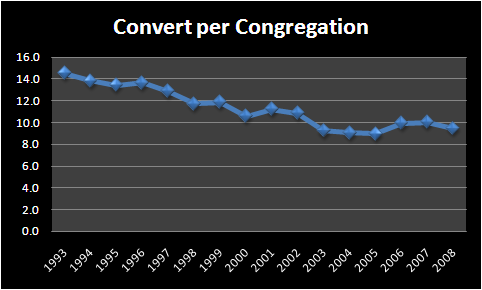
Appendix B: In response to J. Stapley’s Comment # 9
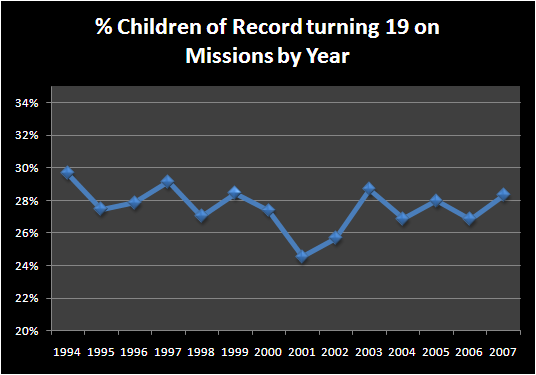
Item of note here is that yes, in 2001-2 there was a dip, but the Bar was raised in October, 2002. If anything, we got more missionaries, not less, from raising the bar.
But I actually think the % Seminary Youth to Missionary tells the story more clearly.
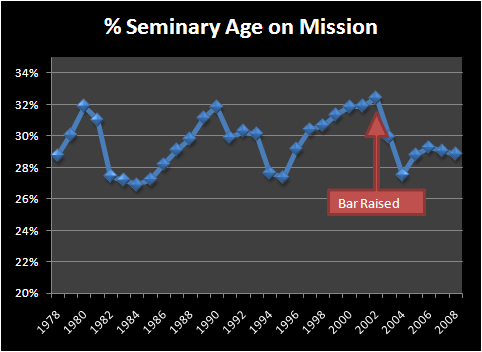
Yes, we say a drop in 2002 here, but we also saw a Drop in 82 and 94. Were there “Bar Raisings” in those years?
Appendix C-
To show the Correlation between all these data points, I pulled the Growth Rates for each point over 94-2007. All together this looks like this.
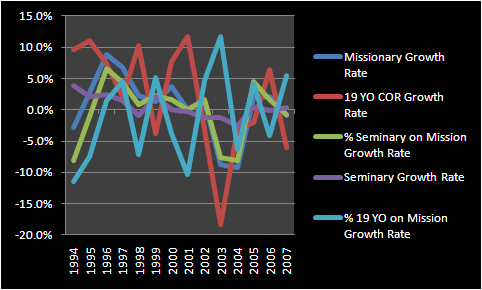
The Idea here is that the Items that have the most Synchronous Growth Rates to the Growth Rate of Missionaries also have the highest correlation.
To make this more clear, I’ve created individual charts of each correlation to the Growth of missionaries.
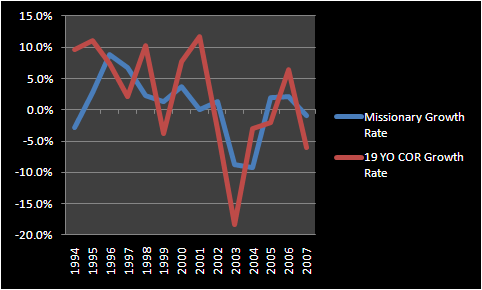
Note the Correlation before 2002 is weak, but suddenly in 2002, as the birth rate rapidly declines, the Children of Record Growth rate takes strong control of the Missionary Quantity. This does not negate the strongest correlation, however.
As can be seen, the number of teenagers either choosing to go on missions or being allowed to go on missions has an extremely strong correlation to the number of missionaries that go on missions. This in fact does show that Raising the bar did have a major impact on the number of missionaries in the field, which was also compounded by the declining birth rate.
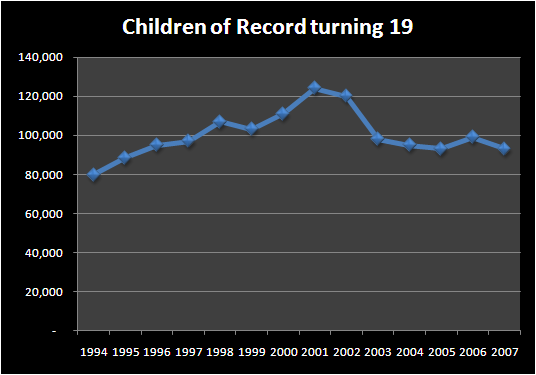
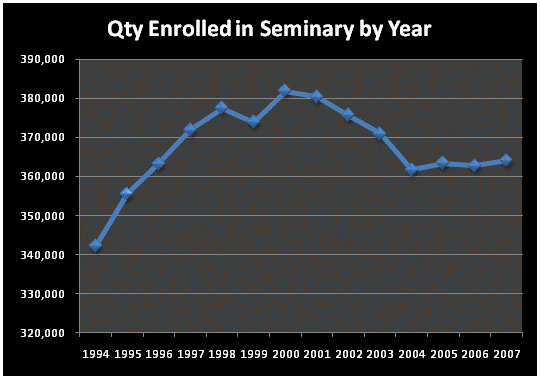
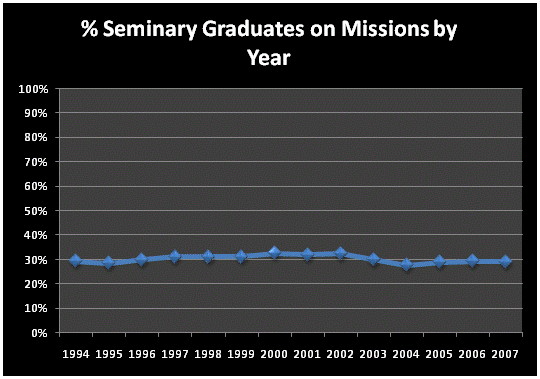
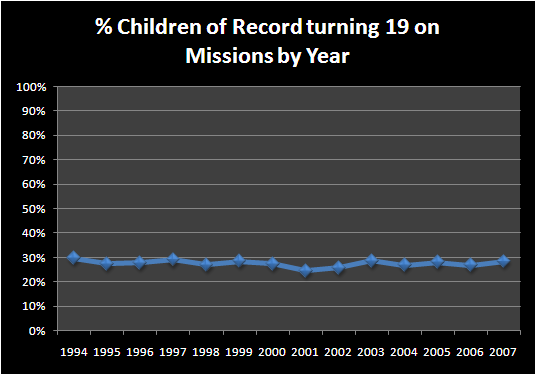
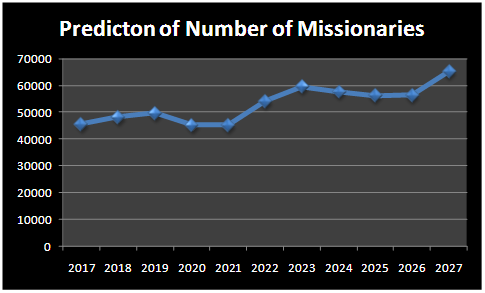
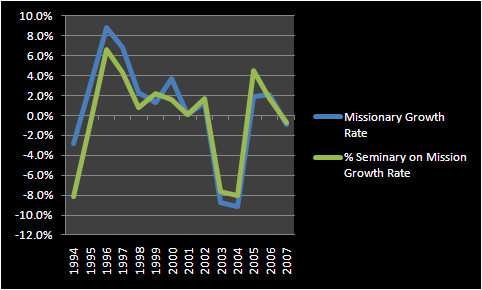


Again, always good to see data so that we make judgments and form conclusions responsibly.
Thanks a lot for this post.
Comment by Joseph Smidt — March 5, 2010 @ 9:28 pm
There was a discussion that evolved into similar comparisons over at BCC a few weeks ago. I took the opportunity to graphically compare mormon birthrates in 1983 to missionarie called in 2002. Of course my graphs aren’t nearly as nice looking as yours, and you took the analysis a bit further.
http://bycommonconsent.com/2010/02/11/mission-restructuring/#comment-175959
http://bycommonconsent.com/2010/02/11/mission-restructuring/#comment-175923
For me the more interesting part of the discussion revolved around the cause of the decline in births. President Hinckley may have played a role in this as well.
Comment by Steve G. — March 6, 2010 @ 12:29 am
Great graphs. Thanks for the data that supports what I had heard. Good to see the evidence.
On fertility rates — is there something about the changing demographic of the church (eg, out of Utah or even the US) that might contribute to that?
I’m especially intrigued to see the long number of 30% years — I remember sitting in a stake PH Leadership meeting years ago (probably 6 or 7), and a member of our stake presidency (then about 70 years old) led the discussion among leaders of young men. He started by saying, “Brethren, we’ve got to do something, but I don’t know what. We’ve had this problem [the decline in activity from Deacon to Priest] as long as I can remember.”
Wish I had a silver bullet to solve the mystery.
Comment by Paul — March 6, 2010 @ 1:18 am
In 1983 President Hinckely told BYU students it was between them and the Lord how many kids they should have and that there was nothing wrong with using birth control. The birthrate dropped shortly thereafter. Maybe it was just a coincidence or maybe not.
Comment by Steve G. — March 6, 2010 @ 7:43 am
As a member of the parenting cohort in question (graduated HS in 1983, got married in 1986, had first of four children in 1988) I don’t have any answers, but I remember that at many times in my children’s lives, they were the only kid in their primary classes despite living large established wards.
There is probably something to be said for the ‘change’ of policy expressed by President Hinckley. It came as such a relief, really. My generation of women grew up with angst-ridden moms who fretted over the correlation issues, ERA issues, birth control issues, and prayer in sacrament meeting issues while making fake grapes for coffee tables… that silent (and sometimes not-so-silent) simmering of trying to figure out what it meant to be a woman in the Church. It felt really good to be acknowledged as appropriate to get personal confirmation from the Lord about how many children to have, rather than to just keep having “as many as come.”
But what I *really* think made the difference in the lower birthrate is seatbelt and car-seat laws that came into effect in the late ’70s and early ’80s. As a practical matter, once those laws came into effect you could only have as many children as you could transport. Our fourth had to wait until we could afford a mini-van.
Comment by Coffinberry — March 6, 2010 @ 8:06 am
(admittedly staying in a North-American only mode) Let me add a little to that… the ubiquitous station wagon of the 60s and 70s seated 9 persons. You could tote mom and dad plus 7 children in it. But it ate gasoline like Cookie Monster ate cookies. The oil crisis of the mid-70s killed the popularity of these family-toting vehicles.
The minivan came out in ’84. It seated 7. Not all seats were safe to use with carseats, so they really only could seat 6. So now you could tote mom, dad, and only 4 (maybe 5) kids.
These popular vehicles sent a social message about how many people ‘ought’ to be in a family, and reinforced practical limits on family size. (I also recall that when my first two children were toddlers, that there was a fire-code law in Los Angeles that limited the number of children that could sleep in an apartment bedroom, and then there were other regulations that limited whether/when they could be mixed gender. I don’t know whether that was true or not but it was certainly the rumor among our RS. Apartment-dwellers were effectively limited in the number of children they could have by the number of bedrooms in their apartments.)
Comment by Coffinberry — March 6, 2010 @ 8:21 am
I am a child of 1984. The “raising of the bar” did indeed keep me from a mission at first. I finally went into the MTC about a month before my 21st birthday.
It was one of the best things that could have happened to me. I don’t think it kept anyone I knew away from a mission. I think that for the most part it inspired us to try to make our lives holier before we went. There were certainly some things I needed to clean up before I cut all my hair off and put on a suit.
As far as birth control goes, my wife and I have been repeatedly counseled to carefully plan when we have kids… from Church leaders, from parents, and peers. I’ve never heard anything anti-birth control in the Church basically ever. I think my generation won’t even know that there even was a controversy. Saturday’s Warrior therefore seems EXTRA strange to us.
Comment by Arthur H. — March 6, 2010 @ 9:37 am
Steve G.- If that is true, then that is the greatest example of following the prophet I’ve ever seen. Also, Did speeches at BYU really get that much air time?
Here is the speech at BYU in question.
The quote in question did not hit the Ensign until 1993, so I am just curious about how the message would have gotten around. (Keep in mind, I didn’t join the church until 1998, so I have no idea the significance of BYU speeches in the 80s)
Coffinberry. That’s an interesting idea. I guess an easy test would be to see if the general population also experience a dip in birth rates in a similar fashion.
Comment by Matt W. — March 6, 2010 @ 9:49 am
I think your % of 19 year-olds on mission slide could use some more analysis. It is hard to discern the data points, but it is important to bare in mind that President Kimball’s massive push to get all worthy males on missions raised the same figure from 24% to 30%. The movement was considered huge (a change of 25%). It looks like there is a similar but inverse dip in 2001-2.
Comment by J. Stapley — March 6, 2010 @ 9:49 am
Coffinberry: Birth rates across the US, while declining did not see the same dramatic shift.
Comment by Matt W. — March 6, 2010 @ 9:52 am
J., I added an Appendix B for you.
Comment by Matt W. — March 6, 2010 @ 10:11 am
Other data points to consider. The Children Gender divide in the church is 49% Male, 51% Female. in 2004, the missionary split was 7% Senior Missionaries (about 5000), 76% Young Men, and 17% Young Women.
To keep things simple, that means 2.75 out of every 10 Youth serving missions are Young Men (~40% of Young Men serve missions, reportedly), and .25 out of every 10 are Young Women. So there is one obvious target audience for improving our quantity of missionaries.
Arthur H.- I enjoyed your comment.
Comment by Matt W. — March 6, 2010 @ 10:22 am
Nice.
Comment by J. Stapley — March 6, 2010 @ 10:53 am
J. I was trying to find Kimball’s impact but my Missionary numbers only got back to 77 from the statistical data. My Children of Record turning 19 was also useless, so I took a stab with the Seminary data at least back to ’77. It seems Kimball’s gains were lost by 1982.
Comment by Matt W. — March 6, 2010 @ 11:14 am
J. From the Seminary Data, I will grant that in 2005, if we had hit 30% instead of 29%, we would have had 4,000 more missionaries that year.
Comment by Matt W. — March 6, 2010 @ 11:49 am
I got figures for Kimball’s period from his biography.
Comment by J. Stapley — March 6, 2010 @ 1:17 pm
But Matt, weren’t general US population birthrates already lower by the early 1980s, such that an average family would fit in a sedan or minivan, and no longer need a Brady-Bunch sized station wagon? Family cars are designed to fit the “average” family. Car trends would not affect the general population because they’re a reflection of the general population. But requiring seatbelts and car seats would effectively push Mormon couples toward conforming to the already existing average family size.
Comment by Coffinberry — March 6, 2010 @ 1:39 pm
I’m not sure if this wording was used intentionally to convey BIC, or just out of rhetorical flourish. If the former, then I don’t follow the logic here. The Church’s annual statistics capture far more children than strictly BIC, which only applies to children whose parents are sealed. Thus, examining Seminary record enrollment would capture incremental converts (which represent a considerably smaller subset of potential missionaries), not all non-BIC children. No?
Comment by Scott B. — March 6, 2010 @ 3:10 pm
We married in the early 70s when there was tremendous pressure (from other members, not from Church leaders) to have children and to have them in larger-than-society’s numbers. I say the pressure came not from leaders, even though Pres. Kimball encouraged couples to not put off family for education or worldly things. So we didn’t and it was wise counsel. We found happiness in family life rather than in following the ways of the world, and that was the point of Pres. K’s counsel.
What I see now is LDS families limiting children to society’s numbers. Two is becoming common and it’s unusual to see a family with four or more. Numbers really don’t matter but the attitude does, which too often is that “children are a burden so we’ll limit ours so that we can move on to other pursuits.”
I too have wondered about the long-term effect on missionary work because of this trend, and the above article has made it very clear.
Comment by Mona — March 6, 2010 @ 3:20 pm
Ouch Scott, that is a stupid error on my part. I meant children of member parents, not BIC…
If that were the only error I made. Please come back for the revised version of this post. I need peer review.
Comment by Matt W. — March 6, 2010 @ 4:48 pm
Please see the revisions in post: In short, when I finally got to proofing my correlation, I found a very strong correlation between Seminary Age kids going on missions and quantity of missionaries. This means that Raising the Bar did have a major impact on the number of missionaries, though the declining birthrate also had a strong correlating impact.
Comment by Matt W. — March 6, 2010 @ 5:26 pm
I think Mona is right that pre-1983, there was significant pressure from peers to have as many children as possible as soon as possible.
A friend of ours who lived in Provo at the time told us, after she had her fourth child, that now her fellow Provo-ites would know she and her husband were “serious” about having a sizable family. We lived in the east when we married, and my wife was asked twice, in the first few months of our marriage, about our “family planning”–i.e., when we were going to have children.
In our extended family, a relative and wife, who were “trying” but had not been able to conceive, reported that there were frequent comments in their university married congregation about the couple’s supposed “failure” to follow the prophet by putting off children. There were periodic lessons in the priesthood manual (I cannot speak to the RS manuals) discouraging the limitation of children except to protect the health of the mother. Many leaders construed that to include consideration of the mother’s emotional health.
I did not hear President Hinckley’s talk, but I read about it in Time or Newsweek. It was a few years later that his guidance became memorailized in the Church Handbook of Instruction, together with the important directive that members “should not judge each other” with respect to the number of their children.
We were beyond child bearing age when the handbook changed, and I cannot speak to whether there is less peer pressure to have a large number of children.
It may be that the reduction in birthrate is attributable to selfish reasons on the part of the parents. It is also possible that, in the absence of peer pressure and expectations, faithful Latter-day Saints who seek God’s guidance are inspired to have smaller families than Saints in earlier years.
Comment by DavidH — March 6, 2010 @ 5:45 pm
Thanks for putting this together, Matt. Fascinating stuff! The birth rate issue is an interesting one.
Comment by Ziff — March 6, 2010 @ 8:38 pm
Thanks Ziff- That means a lot coming from the official ‘naccle data analyst.
Comment by Matt W. — March 6, 2010 @ 9:43 pm
Station wagons were regulated out of existence because they were cars with bad gas mileage. That left us with only minivans and SUVs to choose from which were in a truck category. Not a cheaper or even a more environmentally friendly option.
Comment by jks — March 7, 2010 @ 12:06 pm
Thanks for the interesting analysis. How could we track change over time in the gender composition of the missionary force? I think it would be important to assess the impact of Pres. Hinckley, as well as the rising age at first marriage in Utah, on the number of LDS young women choosing to serve missions.
Comment by Sterling Fluharty — March 7, 2010 @ 2:06 pm
I made this point at an old LDSLF post back in the days when that site existed — i.e., before the hosting company dumped it. Good analysis; this seems right to me. The bar-raise was more symbolic than anything.
Comment by J. Nelson-Seawright — March 8, 2010 @ 10:13 am
JNS- well, it did have an impact, at least when we look at the Seminary data (not so much at the COR data). I just think it’s impact was much less important that the decline in birth rate to the current numbers we have. Of course, I think the birthrate decline isn’t that bad of a thing.
I do think the church needs to step up it’s marketing for the value of going on a mission.
Comment by Matt W. — March 8, 2010 @ 11:51 am
Thank you for putting all this data together – it is really interesting.
Of all of the charts, the one that has the most long-term implications for me is the Converts Per 1000 Members. In a very short time (15 years: 1993-2008), it dropped over 40%, from 35 to 20. I don’t know if this is an aberration or a trend, but it does suggest that Church growth is certainly flattening out.
Concerningly, there is a certain percentage of people who leave the Church each year or die. I don’t have exact numbers for these, but interpolating as best as I can, it seems to be on the order of 6-10/1000 per year. If the converts/1000 members drops another 40% over the next 15 years (ie. from 20->12), it is going to be closing in on the number of people who leave the Church. If those 2 numbers ever match, then we will only have growth through children born in the Church.
Any thoughts on why this is happening or if it’s going to flatten out?
Comment by Mike S — March 8, 2010 @ 1:53 pm
I like this posting. I’ve been tracking these statistics since 1970 through the statistical reports in General Conferences.
.
I especially like the correlation between available 19-year-olds and missionaries in service. A question, though: the Church reported 7.8 million members at the close of 1990. We’ve nearly doubled since then and presumably so would the number of 19-yr-old members. How, beyond seminary enrollments, do you include these converts-to-missionaries?
.
RE: “we also saw a Drop in 82 and 94. Were there “Bar Raisings” in those years?”, 1982 was when the Church experimented for a short while with 18-month missions for our young elders. (My brother served then and I still kid him about not serving a “real” mission). The announced hope at the time was that it would enable more to serve and so increase our feet on the streets. It didn’t and we reverted to 24-month missions shortly afterwards. BTW, elders served 30-month missions until a few years before I began mine in 1971.
.
Another subject for research: I also track the number of member “exits” (deaths, apostacies,and excommunications by
– calculating the increase in church membership for a year
– subtracting the convert baptisms and increases in Children of Record during that year.
Sometimes this left a negative decrease, implying an increase in membership greater than the addition of converts and children of record. (This hasn’t occured in the most recent years).
.
Some possible explanations I have for this are:
– member records’ totals are counted separately from the various incomings and outgoings and they’re not reconciled,
– newly-moved members somehow are reported from new and old units, and
– we’re getting reports from the spirit world.
.
Does anyone have other explanations, besides the snarky ones from our detractors?
Comment by manaen — March 8, 2010 @ 2:12 pm
#30: manaen
I, too, have calculated the “exits” the same way. While there are occasionally “negative” numbers, I think that is more due to reconciliation than anything else. I think the reason it hasn’t happened as much recently is that most units are electronically-based as opposed to paper-based, with nothing much more “snarky” than that.
The more interesting thing about the “exit” numbers to me is the rate per 1000. I have the numbers on a different computer but it would be interesting to plot the “exits” per 1000 against the “converts” per 1000 to see trends. The “converts” per 1000 is down 40% over the past 15 years from the above data to around 20/1000. If my memory is correct, the “exits” are around 8/1000. If the 2 lines were to ever meet, it would mean that the net growth would be neutral except for children born.
This is actually the case in several areas. In a country like Norway, there are around as many members there today as there were 20-25 years ago.
Comment by Mike S — March 8, 2010 @ 3:10 pm
Thanks for the analysis. My recollection of a Pew survey of all religions in the US was that, even though the number of children per family may be declining among Mormons, we far and away have the largest families among Christians, including being substantially ahead of the Catholics. The only ones giving us competition in the birth rate are Muslims. And that is in spite of the delay of two years in getting started on families due to missions. Apparently we still get married younger than most other religions. That means that the rate of growth as a matter of years between generations is faster too. I have two colleagues at work who just turned 60 along with me. One has no kids, and the other has two sons who are not yet married. Our three adult kids have 12 grandchildren between them.
The physical and financial limits on having children are much more severe in other developed nations. In Japan, some apartments are basically just two rooms that get converted into bedrooms in the evening. Having a car is expensive because of the cost of parking. Despite these limitations, the Japanese LDS members are having more kids than the average 1 or 2 of most modern Japanese families. The social barriers to growing up Mormon are also intense. I imagine this is also true for developed Europe.
My daughter has recounted to me that in some of her wards in Colorado Springs, when she had 4 kids, there was a lot of social pressure from working moms on other moms to limit the size of families. I think the working moms felt constrained in how many kids they themselves could raise, and, exhibiting the normal human tendency toward self-justification, used the prevailing cultural language of criticizing large families against their LDS sisters. The counsel about not criticizing other members for their decisions on family size need to be extended the other way as well.
Perhaps having larger families, along with paying tithes and other church offerings, and giving volunteer time to the Church instead of making more money with a second job, or having Mom get a job, places Mormons in an effective lower socio-economic tier, where we don’t have as much disposable income to get involved in activities that distract us from the basic activities of family and church. If you don’t have a lot of funds for jetting off to Cozumel or someplace like that for vacation every year, you will show up at church more often. Having more kids makes us prioritize. In my personal experience, the tendency to go inactive was more pronounced in higher income areas like Marin County, California, where the number of members and congregations has been shrinking for 20 years, than in communities with lower average income levels.
Comment by Raymond Takashi Swenson — March 8, 2010 @ 8:41 pm
I guess the Lord delights in small, well-planned families… unless He wants us to raise seed up unto Him.
Comment by Arthur H. — March 9, 2010 @ 8:54 am